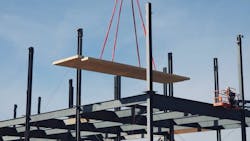Timber! Microsoft Pining for Hybrid Wood in Data Center Construction
Microsoft, big and getting bigger, still believes it can see the forest for the trees when it comes to the mammoth task of building new data centers to be both environmentally and structurally sound.
The tech giant announced recently that it was building new data centers in Virginia partially out of superstrong, ultra-lightweight wood for the first time. The move is an attempt to reduce reliance on concrete and steel which are carbon-intensive materials.
Crews are already installing cross-laminated timber in two data center construction projects. The northern Virginia projects are proceeding with wood after Microsoft engineers reportedly developed what the company called “a hybrid approach” using cross-laminated timber, or CLT.
“The hybrid mass timber, steel and concrete construction model is estimated to significantly reduce the embodied carbon footprint of two new data centers by 35 percent compared to conventional steel construction, and 65 percent compared to typical precast concrete,” wrote Sally Beatty, a corporate news writer for Microsoft Source, in a company post on Oct. 31.
CLT is a prefabricated engineered wood product with layers of solid-sawn or composite lumber, according to the American Wood Council definition.
Microsoft publicly has aimed at being carbon-negative—or taking more carbon out of the atmosphere than it emits—by 2030. Some of its paths to negative or net zero have included long-term renewable energy power purchase agreements (PPA) and a nuclear power supply contract with Constellation Energy that would fund the reopening of Three Mile Island Unit 1 later this decade.
The CLT wood will complement the use of steel and concrete in the new data centers while reportedly cutting emissions. Construction materials currently contribute close to 9% of global greenhouse gas (GHG) emissions, according to United Nations Environment Program tabulations.
The strength-to-weight ratio of CLT is comparable to that of steel and concrete, according to some researchers. Studies have theorized that CLT would reduce the emissions profile of large buildings by as much as 40% over the traditional building blocks.
However, the timber industry does emit GHG through logging and other manufacturing practices. Forests are also carbon sinks, taking CO2 out of the atmosphere, so deforestation impacts would have to be managed.
CLT has risen as a building staple in the European Union, including projects such as the Sara Kulturhus hotel and cultural center built and opened in Skellefteå, Sweden earlier this decade.
Microsoft launched its $1 billion Climate Innovation Fund in 2020 to find and develop less carbon-intensive ways of both building and powering data centers and other facilities. This includes innovations that might happen within the supply chain to reduce Scope 2 and 3 emissions.
“A lot of our suppliers are on the same journey as we are,” Richard Hage, who leads global strategy for datacenter engineering at Microsoft, was quoted in the company post. Everyone is “implementing key initiatives to lower the embodied carbon of their materials and their products.”
In 2021, Microsoft built its new Silicon Valley headquarters partially out of CLT.
Structural engineering firm Thornton Tomasetti worked with architect Gensler on the design of Microsoft’s two new data centers in Virginia.
About the Author
Rod Walton, EnergyTech Managing Editor
Managing Editor
For EnergyTech editorial inquiries, please contact Managing Editor Rod Walton at [email protected].
Rod Walton has spent 17 years covering the energy industry as a newspaper and trade journalist. He formerly was energy writer and business editor at the Tulsa World. Later, he spent six years covering the electricity power sector for Pennwell and Clarion Events. He joined Endeavor and EnergyTech in November 2021.
Walton earned his Bachelors degree in journalism from the University of Oklahoma. His career stops include the Moore American, Bartlesville Examiner-Enterprise, Wagoner Tribune and Tulsa World.
EnergyTech is focused on the mission critical and large-scale energy users and their sustainability and resiliency goals. These include the commercial and industrial sectors, as well as the military, universities, data centers and microgrids. The C&I sectors together account for close to 30 percent of greenhouse gas emissions in the U.S.
He was named Managing Editor for Microgrid Knowledge and EnergyTech starting July 1, 2023
Many large-scale energy users such as Fortune 500 companies, and mission-critical users such as military bases, universities, healthcare facilities, public safety and data centers, shifting their energy priorities to reach net-zero carbon goals within the coming decades. These include plans for renewable energy power purchase agreements, but also on-site resiliency projects such as microgrids, combined heat and power, rooftop solar, energy storage, digitalization and building efficiency upgrades.

